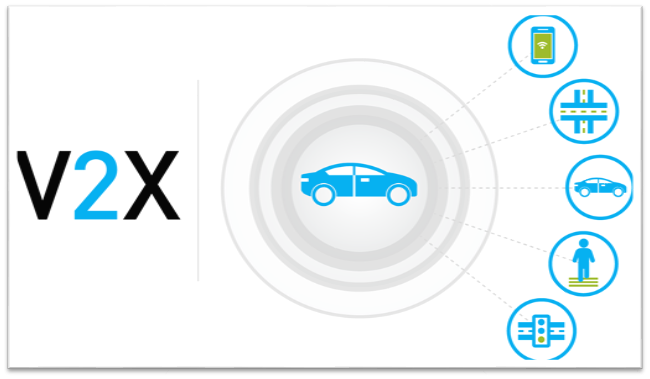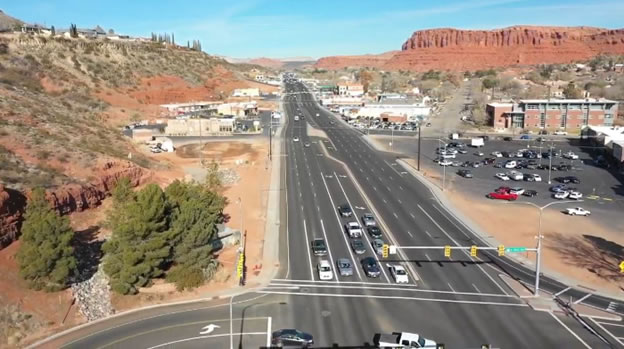
V2X (Vehicle to everything), a system that allows vehicle share and receives real time information with other vehicles, vehicle to pedestrians communication, vehicle to infrastructure communication, traffic management, and road sensors.
Source: Credit to Panasonic Corporation of North America.
| Project Name | Utah “Smart Roadways” Transportation Data Network |
|---|---|
| Location | Utah |
| Project Sponsor | Utah Department of Transportation, Panasonic Corporation of North America |
| Program Areas |
|
| Value Capture Techniques | Joint Development & Right-Of-Way Agreement |
| Mode | Telecommunications |
| Description | The Utah Department of Transportation (UDOT) partnered with Cirrus by Panasonic to develop an intelligent transportation data ecosystem across the state. As home to the country’s first operational connected vehicle corridor, Utah was an ideal candidate for this project. The partnership aims to help Utah accelerate development of a statewide system for collecting, monitoring, and sharing connected and autonomous vehicle (CAV) data. In addition, UDOT expects the intelligent transportation data ecosystem to help the agency achieve its Zero Fatalities mission, with an initial goal of getting annual traffic fatalities down under 200 – a number not achieved since 1950. The “open architecture” Cirrus system is designed to enable other DOTs as well as third-party developers to coordinate with UDOT and develop and connect their own applications to address critical operations, safety, and maintenance needs on Utah roadways. The Cirrus system creates a network where motorists, vehicles, infrastructure, and roadway installations can share data to provide updates on crashes, stalled vehicles, and severe weather. It also allows traffic managers to send out alerts to inform CAV drivers in real-time with alternate routes, delay times, or other helpful information. The foundation of Cirrus is an internet-of-things application program interface layer that lets departments use V2X as a data source for sensing roadway conditions in real time. For instance, onboard units may sense slight tire slippage as roads freeze even before drivers notice. Panasonic secures the data that Cirrus handles by anonymizing it. The vehicles change their signatures to the system at randomized intervals, and the company uses a security credentialing management system similar to that of the U.S. DOT. As part of the $50 million partnership, Panasonic will help UDOT install intelligent sensors along selected sections of Utah highways. These standards-based sensors, along with similar vehicle-mounted software and equipment, will collect and transmit data at speeds up to 10 times per second, which is then shared with a central cloud-based system. This central software platform monitors the information and automatically generates alerts that are shared with vehicles, infrastructure components (such as traffic signals or VMS signs), and UDOT personnel. Once the system is implemented, Utah will be able to accommodate the incoming wave of smart vehicles and operate more safely and more efficiently through communication among vehicles, signs, signals, and other sensors. In addition to having a real-time, full situational awareness of the state’s transportation system, UDOT will also be able to identify traffic chokepoints and use the data network to help reduce congestion and keep traffic moving. In its initial phase, the network includes 40 installation sites, where intelligent sensors will collect and transmit data. A fleet of 30 state-owned vehicles will test the network, which is expected to expand to 220 installation sites and up to 2,000 vehicles. Working with the Utah Transit Authority in 2018, UDOT created the first operational connected vehicle corridor in Salt Lake County to connect the bus system with traffic signals. The bus rapid transit corridor opened between Orem and Provo with a ridership of about 10,000. With the data network, buses running behind schedule are able to extend the length of green lights. |
| Cost | $50 million; Panasonic will help UDOT install intelligent sensors along selected sections of Utah highways in five development phases over a five-year span Phase I: $8 million; 40 installation sites and a fleet of 30 state-owned vehicles Future Phases: will expand to include 220 installation sites and up to 2,000 vehicles |
| Funding Sources |
|
| Project Delivery / Contract Method | Public-Private Partnerships; UDOT/Panasonic Joint Venture |
| Private Partner | Panasonic Corporation of North America |
| Project Advisors / Consultants | N/A |
| Lenders | N/A |
| Duration / Status | In 2017, UDOT put together the Utah Smart Transit Signal Priority project, a pilot for a connected vehicle program. The first network was installed in 2018. Today, the project continues in its first phase with plans to implement the data system statewide. |
| Financial Status/Financial Performance | $50 million; Panasonic will help UDOT install intelligent sensors along selected sections of Utah highways in five development phases over a five-year span |
| Innovations |
|
| Related Links / Articles |
|
| Contacts | John Gleason Betsy Sagges |

The Utah Department of Transportation partners with Panasonic Corporation of North America to develop an advanced transportation data network to improve safety and mobility on the road through data sharing between vehicles, infrastructure, roadways, and traffic operators in real time vehicle-to-everything or V2X technology.
Credit to Panasonic Corporation of North America